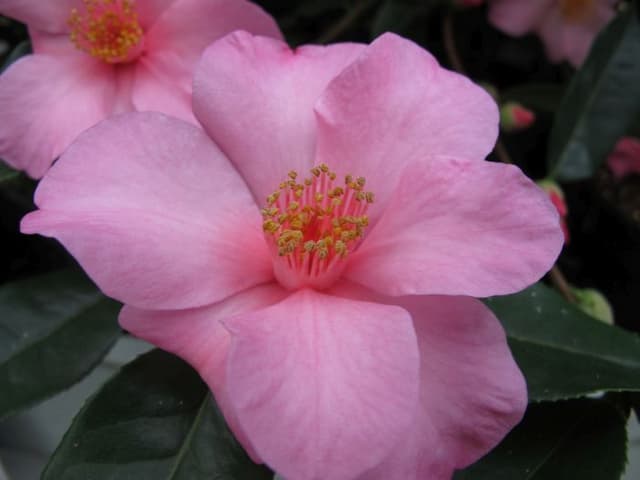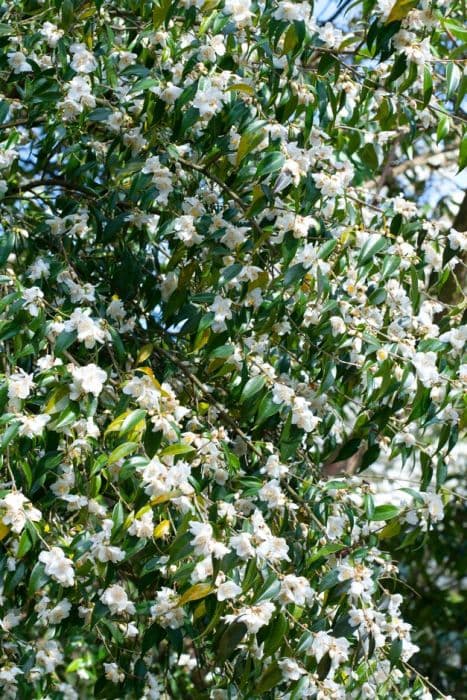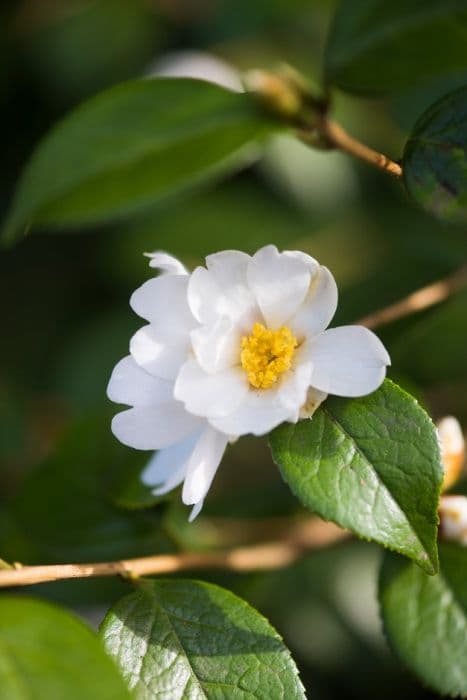Japanese Camellia Camellia japonica 'Silver Anniversary'

ABOUT
The Camellia japonica 'Silver Anniversary' is a striking ornamental plant known for its elegant and sophisticated appearance. The foliage consists of glossy, deep green leaves that provide a lush backdrop for the flowers. It's the flowers that are the standout feature of the 'Silver Anniversary,' displaying an exquisite simplicity that makes this variety special. They are typically large, peony-like blossoms that emerge pure white, hence the name 'Silver Anniversary,' signifying a celebratory and refined quality. These blooms often possess a symmetrical form with layers of petals that sometimes exhibit a subtle hint of cream or ivory near the center, adding depth and warmth to the overall white display. The petals have a distinct texture that can appear almost velvety, and in the heart of the flower, contrasting yellow stamens may be visible, offering a delicate pop of color against the white petals. The plant is revered for its repeated blooming cycle, which can last from late winter through the spring season, sometimes extending into early summer depending on the climatic conditions. Overall, the 'Silver Anniversary' camellia is celebrated for its showy yet refined blooms which can bring a touch of elegance to any garden or landscape setting. It makes a perfect choice for those seeking to commemorate a milestone or simply add a serene and radiant touch to their collection of garden specimens.
About this plant
 Names
NamesSynonyms
Japanese Camellia, Rose of Winter, Tsubaki.
Common names
Camellia japonica 'Silver Anniversary'.
 Toxicity
ToxicityTo humans
Camellia japonica, commonly known as the Japanese camellia, is not considered toxic to humans. There are no well-known toxic effects or symptoms of poisoning from ingesting or coming into contact with this plant.
To pets
Camellia japonica, also known as the Japanese camellia, is generally not regarded as toxic to pets. Neither dogs nor cats are typically affected by ingesting this plant, and there are no significant symptoms of poisoning associated with it. However, as with any non-food plant, ingestion of large quantities may cause mild gastrointestinal upset simply due to the ingestion of non-digestible matter.
 Characteristics
CharacteristicsLife cycle
Perennials
Foliage type
Evergreen
Color of leaves
Green
Flower color
White
Height
6-10 feet (1.8-3 meters)
Spread
6-10 feet (1.8-3 meters)
Plant type
Shrub
Hardiness zones
7-9
Native area
Japan
Benefits
 General Benefits
General Benefits- Ornamental Value: The Camellia japonica 'Silver Anniversary', commonly known as Japanese camellia, has beautiful white flowers that add aesthetic appeal to gardens and landscapes.
- Long Blooming Season: Japanese camellia typically has a long flowering period from late winter to early spring, bringing color to the garden when few other plants are in bloom.
- Evergreen Foliage: This plant retains its glossy, dark green leaves throughout the year, providing continuous foliage interest.
- Screening and Privacy: Due to its dense growth habit, it can be used as a hedge or screen for increased privacy in the garden.
- Versatility: It is versatile in landscape use, suitable for foundation plantings, borders, or as a specimen plant.
- Tolerance to Shade: Japanese camellia can tolerate partial shade, making it suitable for planting under the canopy of larger trees or on the north side of buildings.
- Wildlife Attraction: The flowers may attract pollinators such as bees, providing a food source for local wildlife.
- Low Maintenance: Once established, it requires relatively low maintenance, making it a convenient choice for busy gardeners.
 Medical Properties
Medical PropertiesThis plant is not used for medical purposes.
 Air-purifying Qualities
Air-purifying QualitiesThis plant is not specifically known for air purifying qualities.
 Other Uses
Other Uses- Camellia japonica 'Silver Anniversary', more commonly known as simply Camellia, can be used for bonsai due to its attractive foliage and flowers, making it a favorite among bonsai enthusiasts for its elegance and beauty.
- The wax from Camellia flowers can be used in cosmetics and hair care products, providing a natural ingredient for moisturizers and conditioners.
- Crafted corsages often incorporate Camellias, adding a sophisticated touch to formal wear for occasions such as proms, weddings, or anniversaries.
- Camellia petals can be crystalized and used as edible decorations on desserts, providing an elegant and unique touch to cakes and pastries.
- The camellia's dense foliage provides excellent cover for small birds, offering a natural habitat for nesting and protection from predators.
- Camellia branches can be used in floral arrangements, where their glossy leaves provide a lush backdrop for other flowers within a bouquet or centerpiece.
- The camellia's wood is highly valued for its fine grain and texture, making it suitable for the production of small wooden objects like handles and artisanal crafts.
- Dried Camellia petals can be incorporated into potpourri mixes to add natural fragrance and color to indoor spaces.
- Camellia petals can be used to make a natural dye, which offers a range of pinks and reds for fabric and crafting projects.
- The leaves of the Camellia can serve as a natural mulch or compost material, providing nutrients back to the garden when they decompose.
Interesting Facts
 Feng Shui
Feng ShuiThe Camellia is not used in Feng Shui practice.
 Zodiac Sign Compitability
Zodiac Sign CompitabilityThe Camellia is not used in astrology practice.
 Plant Symbolism
Plant Symbolism- Admiration - The Camellia japonica, commonly known as the Camellia, is often associated with admiration and is given as a gift to express respect and deep fascination to someone.
- Perfection - As a plant with stunning flowers, the Camellia represents the idea of perfection or an ideal beauty.
- Long-lasting Devotion - With its evergreen nature and long blooming period, the Camellia symbolizes the enduring nature of love and is often used to convey the message of someone being deeply devoted over time.
- Affection - The lush blooms of the Camellia are used to express genuine affection towards someone, showcasing heartfelt emotion.
- Excellence - Because the Camellia is considered an exquisite and high-quality flower, it can symbolize excellence or admirable qualities in a person.
 Water
WaterThe Japanese Camellia, including 'Silver Anniversary', should be watered to keep the soil consistently moist but not soggy, as overwatering can lead to root rot. Typically, water the plant with about 1 inch of water per week, adjusting for rainfall. During the growing season in spring and summer, you might need to water more frequently, especially if the weather is dry. In the fall and winter, reduce watering but do not let the soil dry out completely. Always use room temperature water and water the plant at the base to avoid wetting the foliage, which can lead to disease.
 Light
LightJapanese Camellias, such as 'Silver Anniversary', thrive in partial shade with morning sun and afternoon shade being ideal. Avoid direct afternoon sunlight as it can scorch the leaves. A spot that receives dappled sunlight throughout the day or light shade is also suitable.
 Temperature
TemperatureJapanese Camellias like 'Silver Anniversary' prefer a moderate temperature range, with ideal growth occurring between 60 and 70 degrees Fahrenheit. They can withstand winter temperatures down to about 20 degrees Fahrenheit but should be protected from cold drafts and sudden temperature changes. Avoid placing the plant in an area that experiences extreme heat, as temperatures above 80 degrees Fahrenheit may stress the plant.
 Pruning
PruningThe Japanese Camellia 'Silver Anniversary' benefits from pruning to shape the plant, remove any dead or broken branches, and encourage bushier growth. The best time to prune is just after the camellias have finished blooming, usually in late winter or early spring. Do not prune in late summer or fall, as this may remove buds for the upcoming flowering season.
 Cleaning
CleaningAs needed
 Soil
SoilThe best soil mix for Camellia japonica, commonly known as Camellia, should be acidic with a pH between 5.5 and 6.5. A mix of 2 parts peat moss, 1 part perlite, and 1 part organic compost works well. Good drainage is essential to avoid root rot.
 Repotting
RepottingCamellias typically need repotting every 2-3 years to refresh the soil and accommodate root growth. It's best to repot in late winter or early spring before new growth begins.
 Humidity & Misting
Humidity & MistingCamellias thrive in moderate to high humidity levels, ideally around 40-60%. Avoid overly dry air, which can lead to bud drop and leaf problems.
 Suitable locations
Suitable locationsIndoor
Place in bright, indirect light; keep soil moist.
Outdoor
Plant in partial shade; shelter from strong winds.
Hardiness zone
7-9 USDA
 Life cycle
Life cycleThe life of the Japanese Camellia 'Silver Anniversary' begins with seed germination, where warmth and moisture prompt the seeds to sprout roots and shoots. Following germination, the seedling stage involves growth of initial leaves and development of a basic root system. As the plant matures into the vegetative stage, more leaves form, stems thicken, and the root system expands, enabling the Camellia to flourish and increase in size. The reproductive stage commences as the plant develops buds that bloom into the characteristic large, white, ornamental flowers, typically in late winter to early spring. Once pollinated, these flowers produce seed pods that, upon maturation, release seeds to perpetuate the cycle. Throughout its life, the Camellia 'Silver Anniversary' experiences cycles of growth and dormancy, usually triggered by seasonal changes, with active growth in spring and summer, and a period of reduced activity in fall and winter.
 Propogation
PropogationPropogation time
Spring-Early Summer
The Camellia japonica 'Silver Anniversary', commonly known as the Japanese camellia, can be propagated through semi-hardwood cuttings. This is typically done in late summer, after the new growth has begun to mature and harden slightly. To propagate this way, a healthy, disease-free stem about 4 to 6 inches long is selected. The leaves from the lower half of the cutting are removed, and the cut end is dipped in a rooting hormone to encourage root development. The prepared cutting is then placed in a pot filled with a well-draining soil mix, such as half peat and half perlite. It is important to maintain consistent moisture and provide a humid environment by possibly covering the pot with a plastic bag or using a propagation dome. Roots usually develop within 2 to 3 months, after which the new plant can be gradually acclimatized to less humid conditions before eventually being planted out.









